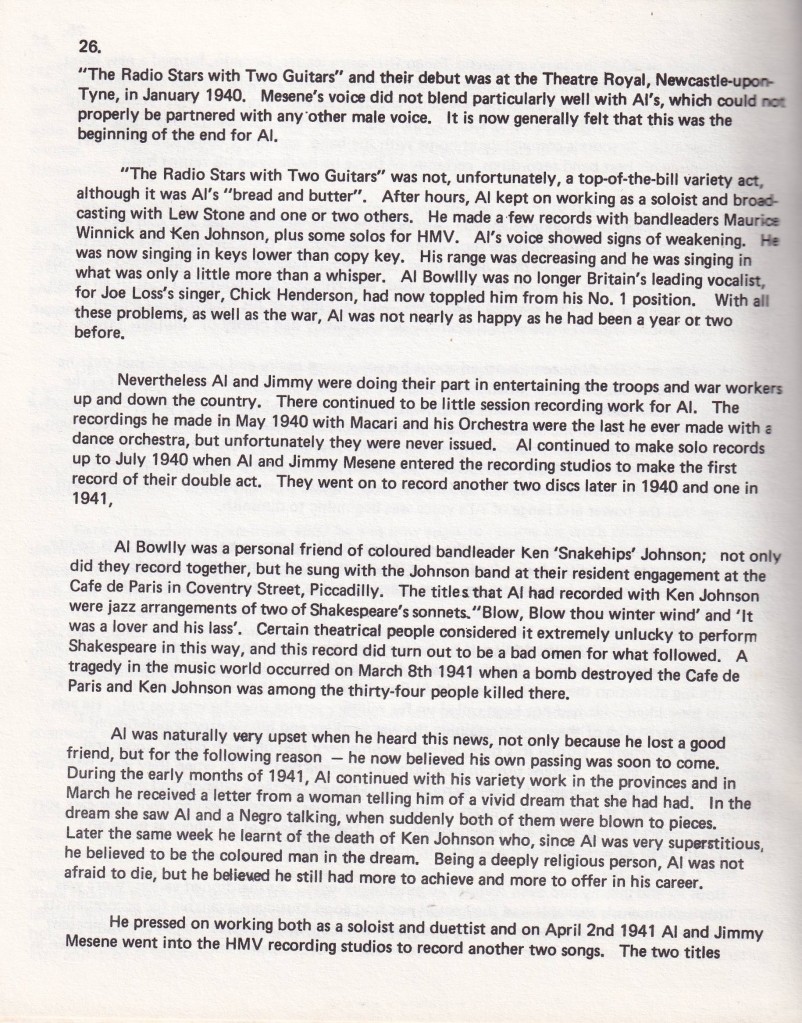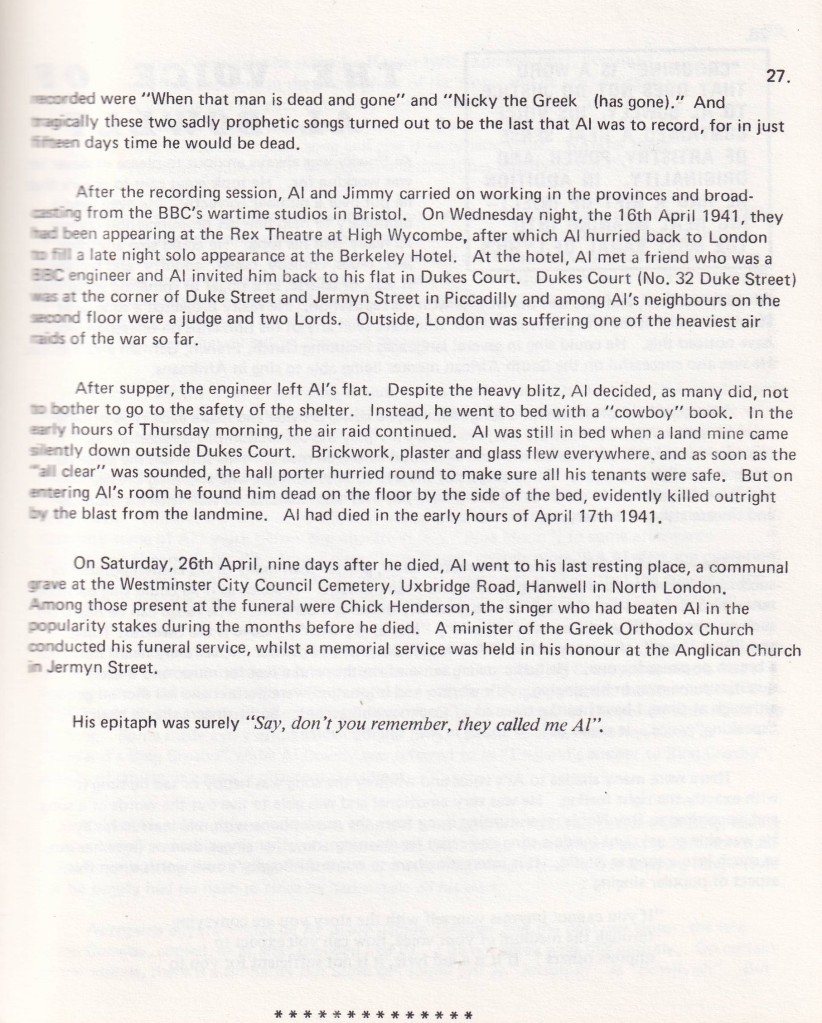FOR THE FIRST TIME – THE FULL FACTUAL STORY OF AL BOWLLY AND HIS LIFE OF MUSIC AND SONG.
WRITTEN AND RESEARCHED BY RAY PALLETT (1975)
Both Al and Jimmy had been feeling the pinch work-wise. As mentioned earlier, there was very little session work available and they could not find good musicians available for accompanists. And so the two of them decided to team up and form a double act. Mesene was a very competent guitarist and they would not have to rely on anyone else for accompaniment. The act was known as “The Radio Stars with Two Guitars” and their debut was at the Theatre Royal, Newcastle-upon-Tyne, in January 1940. Mesene’s voice did not blend particularly well with Al’s, which could properly be partnered with any other male voice. It is now generally felt that this was the beginning of the end for Al.
“The Radio Stars with Two Guitars” was not, unfortunately, a top-of-the-bill variety act, although it was Al’s “bread and butter”. After hours, Al kept on working as a soloist and broadcasting with Lew Stone and one or two others. He made a few records with bandleaders Maurice Winnick and Ken Johnson, plus some solos for HMV. Al’s voice showed signs of weakening. was now singing in keys lower than copy key. His range was decreasing and he was singing in what was only a little more than a whisper. Al Bowlly was no longer Britain’s leading vocalist, for Joe Loss’s singer, Chick Henderson, had now toppled him from his No. 1 position. With all these problems, as well as the war, Al was not nearly as happy as he had been a year or two before.
Nevertheless Al and Jimmy were doing their part in entertaining the troops and war workers up and down the country. There continued to be little session recording work for Al. The recordings he made in May 1940 with Macari and his Orchestra were the last he ever made with a dance orchestra, but unfortunately they were never issued. Al continued to make solo records up to July 1940 when Al and Jimmy Mesene entered the recording studios to make the first record of their double act. They went on to record another two discs later in 1940 and one in 1941,
Al Bowlly was a personal friend of bandleader Ken ‘Snakehips’ Johnson; not only did they record together, but he sung with the Johnson band at their resident engagement at the Cafe de Paris in Coventry Street, Piccadilly. The titles that Al had recorded with Ken Johnson were jazz arrangements of two of Shakespeare’s sonnets.”Blow, Blow thou winter wind’ and ‘It was a lover and his lass’. Certain theatrical people considered it extremely unlucky to perform Shakespeare in this way, and this record did turn out to be a bad omen for what followed. A tragedy in the music world occurred on March 8th 1941 when a bomb destroyed the Cafe de Paris and Ken Johnson was among the thirty-four people killed there.
Al was naturally very upset when he heard this news, not only because he lost a good friend, but for the following reason — he now believed his own passing was soon to come. During the early months of 1941, Al continued with his variety work in the provinces and in March he received a letter from a woman telling him of a vivid dream that she had had. In the dream she saw Al and a black man talking, when suddenly both of them were blown to pieces. Later the same week he learnt of the death of Ken Johnson who, since Al was very superstitious, he believed to be the man in the dream. Being a deeply religious person, Al was not afraid to die, but he believed he still had more to achieve and more to offer in his career.
He pressed on working both as a soloist and duettist and on April 2nd 1941 Al and Jimmy Mesene went into the HMV recording studios to record another two songs. The two titles recorded were “When that man is dead and gone” and “Nicky the Greek (has gone).” And ironically these two sadly prophetic songs turned out to be the last that Al was to record, for in just fifteen days time he would be dead.
After the recording session, Al and Jimmy carried on working in the provinces and broad-casting from the BBC’s wartime studios in Bristol. On Wednesday night, the 16th April 1941, they had been appearing at the Rex Theatre at High Wycombe, after which Al hurried back to London to fill a late night solo appearance at the Berkeley Hotel. At the hotel, Al met a friend who was a BBC engineer and Al invited him back to his flat in Dukes Court. Dukes Court (No. 32 Duke Street) was at the corner of Duke Street and Jermyn Street in Piccadilly and among Al’s neighbours on the second floor were a judge and two Lords. Outside, London was suffering one of the heaviest airs of the war so far.
After supper, the engineer left Al’s flat. Despite the heavy blitz, Al decided, as many did, not to bother to go to the safety of the shelter. Instead, he went to bed with a “cowboy” book. In the carry hours of Thursday morning, the air raid continued. Al was still in bed when a land mine came silently down outside Dukes Court. Brickwork, plaster and glass flew everywhere, and as soon as the “All clear” was sounded, the hall porter hurried round to make sure all his tenants were safe. But on entering Al’s room he found him dead on the floor by the side of the bed, evidently killed outright by the blast from the landmine. Al had died in the early hours of April 17th 1941.
On Saturday, 26th April, nine days after he died, Al went to his last resting place, a communal wave at the Westminster City Council Cemetery, Uxbridge Road, Hanwell in North London. Among those present at the funeral were Chick Henderson, the singer who had beaten Al in the popularity stakes during the months before he died. A minister of the Greek Orthodox Church conducted his funeral service, whilst a memorial service was held in his honour at the Anglican Church Jermyn Street.
His epitaph was surely “Say, don’t you remember, they called me Al”.



This is so terribly sad. I like to believe that Al would’ve got treatment for whatever was wrong with his voice/throat and got his range back like he’d done previously, and been singing well into the 1950s.
LikeLike